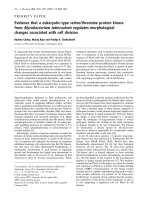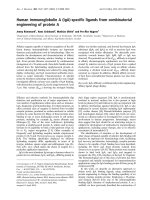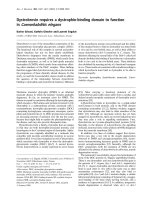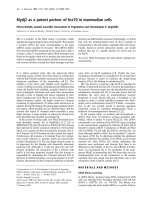Báo cáo y học: "Genome re-annotation: a wiki solution" potx
Bạn đang xem bản rút gọn của tài liệu. Xem và tải ngay bản đầy đủ của tài liệu tại đây (706.44 KB, 5 trang )
Genome Biology 2007, 8:102
Opinion
Genome re-annotation: a wiki solution?
Steven L Salzberg
Address: Center for Bioinformatics and Computational Biology and Department of Computer Science, 3125 Biomolecular Sciences Building,
University of Maryland, College Park, MD 20742, USA. Email:
Published: 1 February 2007
Genome Biology 2007, 8:102 (doi:10.1186/gb-2007-8-1-102)
The electronic version of this article is the complete one and can be
found online at />© 2007 BioMed Central Ltd
So you think that gene you just retrieved from GenBank [1] is
correct? Are you certain? If it is a eukaryotic gene, and
especially if it is from an unfinished genome, there is a pretty
good chance that the amino acid sequence is wrong. And
depending on when the genome was sequenced and
annotated, there is a chance that the description of its
function is wrong too.
Large-scale genome sequencing has revolutionized biology
over the past ten years, generating vast amounts of new infor-
mation that has radically transformed our understanding of
hundreds of species, including ourselves. Sequencing centers
continue to churn out new DNA sequences for a fantastic
variety of species, covering more and more of the tree of life.
Along with these sequences, the centers also produce
genome annotation, which includes the locations and
descriptions of all identifiable genes. These gene lists are the
first pictures we get of what’s inside a newly sequenced
genome, and they can reveal key insights into what makes an
organism distinctive. Sometimes the gene lists themselves
are part of the story; for example, when the human genome
was published [2,3], the headline was that humans have
‘only’ 25,000 genes, in contrast to earlier estimates of
100,000 or more. For many microbial species, the genome
helps us to understand how the organism can accomplish
something particularly difficult, such as how Deinococcus
radiodurans (to cite just one of many examples) can
withstand exposure to radiation levels far in excess of what a
human could tolerate [4]. With each new human pathogen,
the gene list helps us determine how the organism infects
humans, how it causes sickness and (sometimes) how it
becomes resistant to antibiotics. For these and other
reasons, the accuracy of the gene list is tremendously
important.
What is genome annotation?
Before addressing the problems with annotation, I will first
summarize how it is done. The process of sequencing and
annotating the DNA of a bacterial species has become highly
automated in recent years, but the major steps are quite
similar to what was done for the very first bacterial genome,
Haemophilus influenzae, in 1995 [5].
Figure 1 shows an outline of the main steps of the whole-
genome shotgun sequencing and annotation process for a
bacterial genome. Similar procedures - for both sequencing
and annotation - are followed for much larger genomes,
including the human genome, although the details vary. The
laboratory steps have not changed greatly since
H. influenzae: they begin with DNA purification, followed by
shearing the DNA into countless small fragments (the
‘shotgun’ step). These fragments are then cloned and
sequenced from both ends and assembled, usually resulting
in a set of contiguous DNA sequences (contigs) joined
together into larger scaffolds. The annotation pipeline can be
applied immediately to these contigs, but in projects where
the genome will be finished, the annotation software is
usually run later, when the gaps between contigs have been
filled in.
Abstract
The annotation of most genomes becomes outdated over time, owing in part to our ever-improving
knowledge of genomes and in part to improvements in bioinformatics software. Unfortunately,
annotation is rarely if ever updated and resources to support routine reannotation are scarce. Wiki
software, which would allow many scientists to edit each genome’s annotation, offers one possible
solution.
Most annotation pipelines are considerably more complex
than shown in Figure 1, but they share the same outline.
First a gene finder (such as, for bacteria, Glimmer [6] or
GeneMark [7]) is run over the genome, producing a set of
predicted protein-coding genes. These programs are very
accurate, though not perfect. They are far more accurate
than eukaryotic gene finders, however, primarily because the
problem is far more difficult in eukaryotic genomes. In
either case, the next step in the pipeline is to take the set of
predictions and search them against one or more protein
databases using BLAST [8], HMMer [9] or other programs.
For each gene that has a significant match, the BLAST
output can be used to assign a name and function to the
protein. The accuracy of this step depends not only on the
annotation software, but also on the quality of the
annotations already in the database. For genes with no
match, the pipeline might keep them and label them as
‘hypothetical’, or it might discard them based on criteria as
simple as minimum length.
Annotation pipelines also run separate searches for tRNA
and rRNA genes, and they may include other components as
well. The pipeline software will usually take extra steps to
find any genes missed by earlier steps; typically this involves
running a translated search, aligning all six possible
translations of the unannotated sections to a database.
Partial and draft genomes
Finishing a genome - sequencing every remaining nucleotide
of every chromosome and creating a gap-free assembly - is
considerably slower and more expensive than the high-
throughput shotgun-sequencing phase. As a result, a
growing number of genomes are being released in ‘draft’
form and will remain in this form indefinitely. These include
many bacteria and the majority of eukaryotic genomes. (In
fact, only a handful of eukaryotic genomes, such as those of
Saccharomyces cerevisiae and Caenorhabditis elegans but
not including the human, are truly finished.)
102.2 Genome Biology 2007, Volume 8, Issue 1, Article 102 Salzberg />Genome Biology 2007, 8:102
Figure 1
Overview of sequencing and annotation for a whole-genome shotgun project, for example, sequencing a bacterial genome. First (a), genomic DNA is
purified, broken into short fragments and cloned into E. coli. The cloned fragments are then sequenced from both ends on an automated sequencing
machine. The resulting sequences (shown in (b) as they appear on the sequencing machine display) are then assembled using a complex software
program that identifies overlaps into (c) large, contiguous sequences representing the chromosomes from the original DNA. Gaps are filled until the
genome is complete. (d) Annotation begins with the execution of several gene-finding programs, such as Glimmer, which identifies protein-coding genes,
tRNAScan, which identifies tRNAs, and other programs for other genome features. (e) These initial predictions are used as the basis for BLAST searches
against large protein databases, which identify related proteins based on sequence similarity. Translated (Blastx) searches are then used to scan the
databases to detect any proteins that match the DNA regions in between predicted genes. Customized annotation programs are used to decide what
name and function to assign to each protein, leading to (f) the final annotated genome.
Blast,
Blastx
Glimmer
tRNAScan
(d)
(a)
(e) (f)
(b) (c)
The effect of draft genomes upon annotation is considerable:
many genes will ‘run off’ the end of contigs or appear on two
or more separate contigs. This in turn complicates the subse-
quent steps of annotation and is likely to lead to additional
errors in assigning gene function. For example, a gene
fragment is liable to match a small protein domain, and
functions based on a single domain hit are not reliable. A gene
that is split across two contigs might be annotated twice. Draft
sequences also have much higher sequencing error rates,
which can introduce erroneous stop codons in the middle of
genes or improperly merge adjacent but distinct genes.
The role of GenBank
Once a genome - draft or complete - is annotated, the DNA
sequence along with the annotation is normally deposited in
GenBank. Countless researchers rely on GenBank [1], EMBL
[10] and DDBJ [11] (which mirror one another) as their
primary source for genome annotation, and for a good
reason: these databases are the world’s largest public
repositories of genome information. GenBank now contains
over 65 billion base pairs (Gbp) of sequence, up from just
2 Gbp in 1998 and 10 Gbp in 2000, and it continues to grow
at an astonishing rate. If you want to find a gene, GenBank
should definitely be your first stop. Yet I frequently hear
claims within the bioinformatics community that the
‘GenBank annotation’ of a particular genome is fraught with
problems, and that the speaker can fix them.
Is the GenBank annotation perfect? Of course not. How good
it is, though, depends on many variables, and the consumer
of GenBank data would be wise to be aware of them (in other
words, caveat emptor). The first and most important point
to understand is that GenBank is not simply a database; it is
also a library. A scientist who submits a sequence to
GenBank is the owner of that sequence and is listed on the
‘author’ line in the GenBank entry. Just as with any article
published in a journal, the author (and only the author) has
the right to submit an erratum. Because GenBank is an
electronic library, an erratum is really an update: new
sequences or annotations replace the old ones, although
GenBank keeps a record of the changes so that the original
entry can still be retrieved if necessary. This notion of
GenBank as a library (or an electronic journal) is frequently
misunderstood, especially when a scientist discovers an
annotation error. Even if the error is overwhelmingly
obvious, the custodians of GenBank cannot simply fix it, any
more than the editor of a journal can correct one of the
papers published in that journal. Another way to think of
this is to recognize that a ‘GenBank annotation’ is not
‘GenBank’s’ annotation, but rather the annotation of
whoever deposited the sequence in the first place.
When confronted with this problem, some scientists react by
suggesting that GenBank (and DDBJ and EMBL) should
allow scientists to fix errors that they find. But this would
quickly destroy the archival function of GenBank, as original
entries would be erased over time. It would also violate the
agreement that GenBank has with all its submitters that their
entries belong to them and can only be changed by them. This
agreement has been crucial in GenBank’s near-universal
acceptance by the genomics community as the central
resource for DNA sequences. The idea of allowing others to
alter GenBank annotation also immediately begs the question
of who should be permitted to make such alterations.
This leaves us with a problem: users go to GenBank
expecting to find the authoritative annotation for a genome,
and what they find might be far less than that. Most genome
annotation deposited in GenBank remains static for years,
and many annotations have never been changed since their
initial publication. Nonetheless, many scientists assume that
GenBank annotation is kept up to date, and they are
surprised to hear that it is not.
For example, 479 genes in the H. influenzae Rd genome are
currently listed as hypothetical proteins. Of these, 217 have
at least one extremely strong BLAST hit to another species
(E-value < 10-100), which means they should at least be
called ‘conserved hypothetical’ proteins. And 40 of these
have matches to a gene with an assigned function, meaning
that a re-annotation would result in these genes having a
more meaningful name than ‘hypothetical protein’.
Some inconvenient truths
Even considering all of the issues above, one might
reasonably expect that as protein databases have grown,
annotation has improved and that recently annotated
genomes (at least) will be of the highest quality. This is not
quite true. What is true is that a BLAST search of a protein
that is run today will yield far more results than it would
have five or ten years ago, and these results in turn should
lead to better annotation. Not all software is equally good,
however, and the annotation pipelines vary considerably in
their quality. There is also wide variation in the skills and
experience of those operating the pipelines. Further
complicating matters, some genomes are subjected to careful
curation and review, whereas others receive only automated
annotation. In the early days of sequencing, the sequencing
teams included experts on the biology of each genome, and
their manual curation dramatically improved the annotation
of those species. Today that is no longer true: high-
throughput sequencing centers are large, efficient factories
with unique expertise in the methods necessary for
sequencing, but they sometimes have very little expertise on
the biology of the species they are sequencing. The
inconvenient truth is that, as a result of these factors and
others, some genomes are poorly annotated even today.
There are several ways in which genome annotation can be
erroneous. The first and most fundamental is simply that the
Genome Biology 2007, Volume 8, Issue 1, Article 102 Salzberg 102.3
Genome Biology 2007, 8:102
gene models may be wrong. Although bacterial gene-finding
systems [6,7] are highly accurate, finding 98-99% of protein-
coding genes in most species, they still occasionally miss
genes. Their accuracy at placing the start site is a bit lower,
probably closer to 90%, which is excellent but far from the
perfect accuracy that some might expect. In the past, the
accuracy of (bacterial) start-site prediction was closer to
80%, and many of the genomes in GenBank were predicted
with earlier versions of gene finders. Note that all these
accuracy figures are much lower for eukaryotic annotation.
Some annotation pipelines include algorithms to adjust start
sites, which can be done by looking closely at the boundaries
of alignments to homologous proteins.
False positives represent another type of erroneous anno-
tation: when the prediction of a gene-finding program does
not match any previously known protein, the annotators (or
the annotation pipeline software) must decide whether or not
to include that prediction in the gene list. Over the years,
annotation groups have used a variety of rules to make this
decision, and they have inevitably included thousands of false
predictions in the publicly available genome annotation.
These predictions are mostly harmless unless they result in
effort being expended trying to verify them. In some cases,
too, they might ‘hide’ functional RNA genes or true genes in a
different reading frame from that of the false prediction.
Perhaps the biggest problem with genome annotation is
erroneous and inconsistent naming of genes. Much of this is
due to the simple fact that our knowledge of genes has
improved but the annotation has remained static. Thus a
gene labeled ‘hypothetical protein’ a few years ago might now
have a known function. A second problem is what’s known as
transitive catastrophe: the phenomenon whereby a name is
transferred from one gene to another on the basis of sequence
similarity (usually from a BLAST search) but where the
original name is incorrect. As more genomes are annotated,
and more BLAST searches are run, the name gets transferred
to other proteins, and the original source of the name quickly
becomes lost. It is well known in the genomics community
that thousands of such transitive errors have propagated
through sequence databases, and efforts are under way to try
to clean up some of the mess. In the meantime, though, many
genes remain incorrectly annotated.
Let us consider just one example, selected more or less at
random from the bacterium H. influenzae Rd [4]. The gene
fdxH encodes formate dehydrogenase, β subunit, GenBank
accession number NP438180. When the genome was
sequenced in 1995, this gene (encoding a 312 amino acid
protein) was similar to very few other genes; even the
orthologous Escherichia coli gene was not yet sequenced. It
is very difficult today to reconstruct what the best BLAST hit
was back then, but today there are 197 highly significant
BLAST hits to 123 distinct species. Thus, it is pretty clear
that this gene today should be well-annotated because of the
multitude of highly similar proteins. Yet if we look at the list
of matching proteins, we find a variety of names given,
including not only the name found on NP438180 itself, but
also: formate dehydrogenase-O β subunit; formate dehydro-
genase, nitrate-inducible, iron-sulfur subunit; HybA protein;
formate dehydrogenase-N, Fe-S β subunit, nitrate-inducible;
hypothetical protein PaerPA_01004979; hypothetical protein
Bpse11_03005113; 4Fe-4S ferredoxin, iron-sulfur binding;
and Twin-arginine translocation pathway signal. Some of
these names seem to be synonymous, but others clearly are
not. To decide properly among them, we need to look at the
source of each annotation and at the species to which it is
attached.
Possible solutions
So if we can’t always trust GenBank, what can we do? Clearly
we cannot just ignore it. The scientific community must have
a resource that contains the genes from all the species that
have been sequenced. For the past 25 years, GenBank,
EMBL and DDBJ have been enormously successful at
providing these data. The pace of sequencing has changed
the rules of the game, however: sequencing centers are
pouring out genomes, annotating them rapidly and moving
on. An archive of these annotations may be useful, but a
static archive is insufficient.
One part of the solution is obvious: annotation must be
regularly re-computed using the latest databases and
software. For a small number of model organisms, this is
already happening, but these species represent a tiny
proportion of all known genes. Simply re-running an
automated pipeline on all genomes is not sufficient, though,
because that would over-write many of the carefully curated,
manually annotated genes that have been produced in the
past. Unfortunately, there is no standard label attached to
such genes, so there is no way for an automated pipeline to
know that they should be trusted. Therefore, we also need to
launch an effort to start identifying those genes that are well
annotated and, beyond that, to start recording the evidence
used to annotate each gene.
Another solution is to create a new, expanded database that
can display all the alternative annotations for any locus in a
genome. If this were available, then scientists could be
provided with links from any gene to alternative or over-
lapping gene predictions as well as alternative gene names.
Along with each annotation could be a link to the evidence
supporting it; for example, the date of a BLAST search or a
citation to experiments contained in a journal article.
A wiki solution?
Various members of the genomics community have
considered these and other solutions, but so far none have
emerged as the standard. Several new databases have been
102.4 Genome Biology 2007, Volume 8, Issue 1, Article 102 Salzberg />Genome Biology 2007, 8:102
developed with alternative genome annotation, or with re-
annotation (for example, the TIGR Comprehensive Microbial
Resource [12]), but none of them has attracted nearly as
much web traffic as GenBank or the other databases at NCBI
[13]. The difficulties in changing this system are many: first,
for example, there are some genomes for which GenBank is
still the best source, and second, if another, better source of
annotation exists, how is someone to discover it?
A relatively new model of sharing expertise through the
Internet might offer a solution. This model is the ‘wiki’: a
shared resource that anyone can edit. This open-editing
framework for websites and data was first introduced in
1995, and it was initially viewed with skepticism by many in
the Internet community, who argued that wiki-based
websites would be filled with unreliable, inaccurate infor-
mation. But the success of the online encyclopedia Wikipedia
[14] has demonstrated that, despite the skeptics, a wiki site
can be accurate, up-to-date and incredibly useful. Genome
annotation has many of the same features of an encyclo-
pedia: the information required to produce it is broad-based
and the expertise is scattered around the scientific
community in a very wide range of laboratories, most of
whom are not connected to genome projects. I therefore
propose that a ‘genome wiki’ might provide just the solution
we need for genome annotation. A wiki would allow the
community of experts to work out the best name for each
gene, to indicate uncertainty where appropriate and to
discuss alternative annotations. Although wikis will not (and
should not) supplant well-curated model-organism databases,
for the majority of species they might represent our best
chance for creating accurate, up-to-date genome annotation.
Whether or not a genome wiki emerges, we will probably
need an archival repository of annotation for many years to
come. The international database consortium represented by
GenBank, EMBL and DDBJ has served that purpose
remarkably well for a long time and will continue to do so.
Despite this success, the genomics community needs an
accurate, continually updated source of genome annotation
for every species, and we can hope that a solution to this
problem will emerge in the near future.
References
1. GenBank [ />2. The International Human Genome Sequencing Consortium: Initial
sequencing and analysis of the human genome. Nature 2001,
409:860-921.
3. Venter JC, Adams MD, Myers EW, Li PW, Mural RJ, Sutton GG,
Smith HO, Yandell M, Evans CA, Holt RA, et al.: The sequence of
the human genome. Science 2001, 291:1304-1351.
4. White O, Eisen JA, Heidelberg JF, Hickey EK, Peterson JD, Dodson
RJ, Haft DH, Gwinn ML, Nelson WC, Richardson DL, et al.:
Genome sequence of the radioresistant bacterium Deinococ-
cus radiodurans R1. Science 1999, 286:1571-1577.
5. Fleischmann RD, Adams MD, White O, Clayton RA, Kirkness EF,
Kerlavage AR, Bult CJ, Tomb JF, Dougherty BA, Merrick JM, et al.:
Whole-genome random sequencing and assembly of
Haemophilus influenzae Rd. Science 1995, 269:496-512.
6. Delcher AL, Harmon D, Kasif S, White O, Salzberg SL: Improved
microbial gene identification with GLIMMER. Nucleic Acids Res
1999, 27:4636-4641.
7. Lukashin AV, Borodovsky M: GeneMark.hmm: new solutions
for gene finding. Nucleic Acids Res 1998, 26:1107-1115.
8. Altschul SF, Madden TL, Schaffer AA, Zhang J, Zhang Z, Miller W,
Lipman DJ: Gapped BLAST and PSI-BLAST: a new genera-
tion of protein database search programs. Nucleic Acids Res
1997, 25:3389-3402.
9. Eddy SR: Profile hidden Markov models. Bioinformatics 1998,
14:755-763.
10. EMBL Nucleotide Sequence Database [ />embl/]
11. DNA Data Bank of Japan [ />12. Peterson JD, Umayam LA, Dickinson T, Hickey EK, White O: The
Comprehensive Microbial Resource. Nucleic Acids Res 2001, 29:
123-125.
13. National Center for Biotechnology Information [http://www.
ncbi.nlm.nih.gov/]
14. Wikipedia [www.wikipedia.org]
Genome Biology 2007, Volume 8, Issue 1, Article 102 Salzberg 102.5
Genome Biology 2007, 8:102









